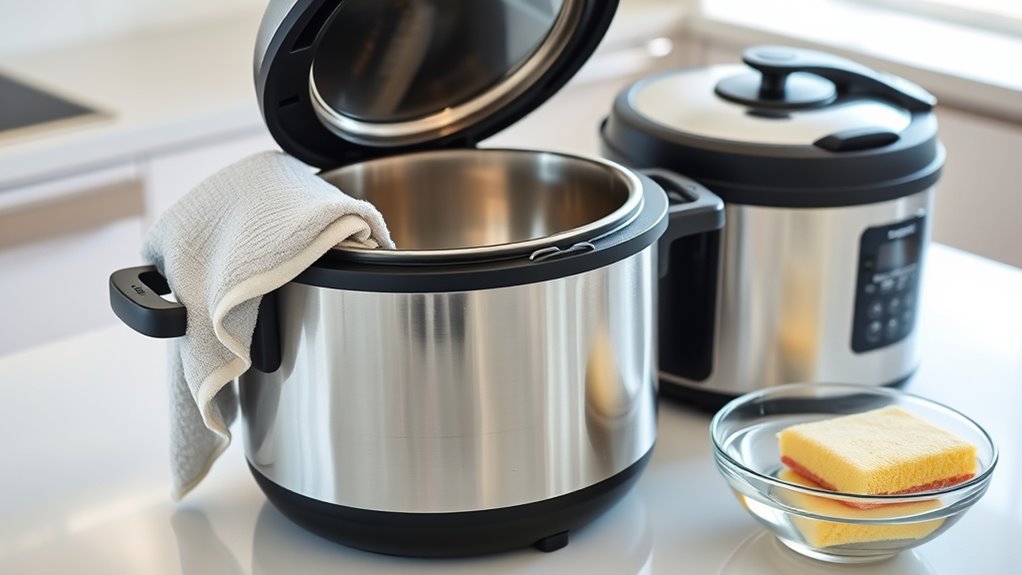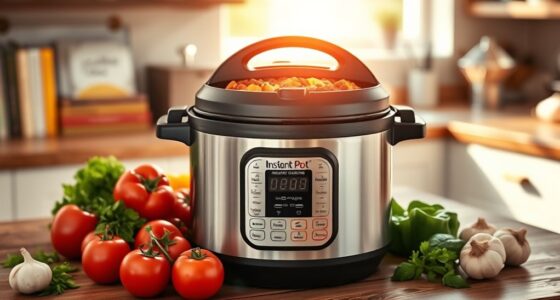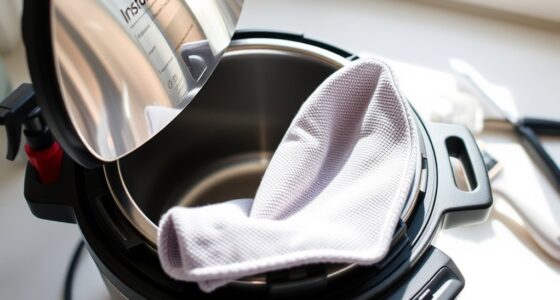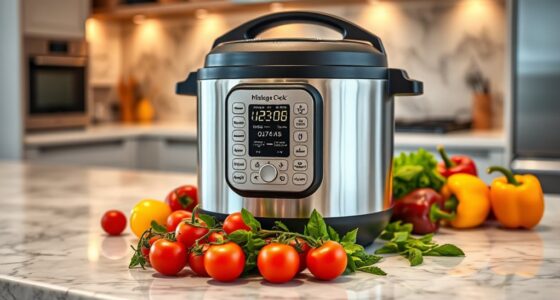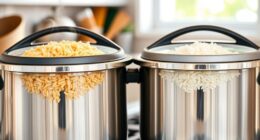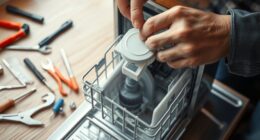To keep your multicooker in top shape for years, always unplug and let it cool before cleaning. Gently remove and wash the inner pot, lid, and sealing ring with mild soap and warm water, drying them thoroughly. Wipe the exterior and control panel with a soft cloth, and tackle stubborn stains or odors with vinegar or baking soda. Regular inspections and a consistent cleaning routine will guarantee safe operation and longer lifespan—learn more about proper maintenance next.
Key Takeaways
- Always unplug and allow the multicooker to cool completely before cleaning to ensure safety and prevent damage.
- Regularly wash and thoroughly dry the inner pot, lid, sealing ring, and accessories to maintain performance and prevent odors.
- Clean the exterior and control panel with a soft, damp cloth, avoiding abrasive cleaners to preserve appearance and functionality.
- Inspect and replace worn parts like sealing rings and accessories promptly to ensure safety and optimal operation.
- Establish a routine cleaning schedule after each use and perform periodic checks of the heating element for longevity.
Unplug and Cool Down Before Cleaning

Before you begin cleaning your multicooker, always unplug it and let it cool down completely. This safety precaution prevents electrical hazards and burns. Never attempt to clean the appliance while it’s still hot or plugged in. To guarantee safe handling, wait at least 30 minutes after use, especially if you’ve cooked something hot. Regular cleaning frequency depends on how often you use the multicooker; more frequent cleaning helps maintain its performance and hygiene. Remember, neglecting safety precautions can lead to accidents or damage. Always double-check that the power cord is unplugged and the device is cool before starting. Additionally, understanding multicooker maintenance can help you better care for your appliance and extend its lifespan. Taking these steps ensures your cleaning process is safe and effective, prolonging your multicooker’s lifespan.
Remove and Clean the Inner Pot

To clean your multicooker properly, start by removing the inner pot from the main unit. Wash it with mild soap and warm water, making sure to scrub away any food residue. After cleaning, dry the inner pot thoroughly before reinserting it into the cooker. Regular cleaning with appropriate materials helps maintain the appliance’s performance and prolongs its lifespan.
Detach the Inner Pot
Detaching the inner pot from your multicooker is a straightforward step that makes cleaning easier and more thorough. To do this effectively, keep these points in mind:
- Inner pot removal should be gentle to avoid damaging the non-stick coating or handles.
- Check compatibility considerations: ensure your inner pot is compatible with your model before removing or cleaning it.
- Handle the inner pot carefully, especially if it’s hot or wet, to prevent accidental drops or damage.
- Regularly inspecting your inner pot can help identify signs of wear or damage that may affect the multicooker’s performance filter replacement.
Wash With Mild Soap
Washing your inner pot with mild soap is essential for maintaining its non-stick surface and ensuring food tastes fresh. Start by applying a small amount of gentle soap to warm water and creating soap suds. Use a soft sponge or cloth to gently scrub the interior, avoiding abrasive materials that could damage the coating. Focus on removing any food residue or stains, but don’t use harsh scrubbing that might scratch the surface. Rinse thoroughly with clean water to remove all soap traces. Proper cleaning with mild soap helps preserve the non-stick properties and prevents lingering odors. After washing, guarantee you dry the inner pot completely before storing or reassembling your multicooker. Regular, gentle cleaning keeps your appliance in top shape and extends its lifespan. Incorporating sound healing science principles like gentle vibrations during cleaning can also promote better maintenance.
Dry Thoroughly After
After removing the inner pot from your multicooker, it’s vital to dry it thoroughly to prevent moisture buildup and potential corrosion. Air dry the pot by placing it in a well-ventilated area, guaranteeing no water remains. To speed up the process, you can gently wipe it with a clean, dry towel. Here are some tips to ensure complete dryness: 1. Avoid moisture buildup by inspecting all seams and corners. 2. Use a soft cloth to remove any remaining water or residue. 3. Allow ample air dry time before storing or reassembling, preventing trapped humidity. Additionally, ensure the proper placement of your multicooker for optimal airflow and drying efficiency.
Clean the Lid and Sealing Ring

Since the lid and sealing ring are key to your multicooker’s performance, keeping them clean is vital. Regular lid maintenance and sealing ring care prevent odors, bacteria, and leaks. Remove the lid and sealing ring, then wash them with warm, soapy water. Use a soft brush or cloth to scrub away residue. For stubborn stains, soak the parts in vinegar solution for 15 minutes. Rinse thoroughly and dry completely before reassembling. Proper cleaning guarantees your multicooker functions properly and extends its lifespan. Incorporating industry trends into your maintenance routine can also help ensure optimal performance and longevity.
Wipe Down the Exterior and Control Panel

Use a soft cloth to wipe down the exterior and control panel, ensuring you don’t scratch the surface. Avoid abrasive cleaners that could damage the finish or buttons. After cleaning, dry everything thoroughly to prevent moisture buildup. For optimal performance and longevity, regularly inspecting and maintaining your appliance aligns with best practices in Volkswagen Tuning.
Use Soft Cloth
To keep your multicooker looking its best, regularly wiping down the exterior and control panel with a soft cloth is vital. Use a gentle polishing technique to prevent scratches or damage. Here are three tips to ensure proper cleaning: 1. Choose a clean, damp soft cloth for gentle cleaning without harsh chemicals. 2. Avoid abrasive materials that could scratch the surface. 3. Focus on wiping in a circular motion to remove smudges and fingerprints effectively. Additionally, maintaining the appearance quality of your appliance involves regular cleaning to prevent dust buildup and ensure longevity.
Avoid Abrasive Cleaners
Avoid abrasive cleaners when wiping down your multicooker’s exterior and control panel, as these can cause scratches and damage the surface. Instead, opt for gentle cleaning methods that won’t harm the finish. Use soft cloths or microfiber towels paired with mild, chemical free solutions like diluted vinegar or a gentle dish soap. These natural alternatives effectively clean without leaving residue or risking surface deterioration. Steer clear of harsh scrubbers or abrasive pads, which can scratch or dull the exterior. Regularly wiping down with gentle cleaning keeps your multicooker looking new and functioning properly. Remember, gentle cleaning preserves the surface’s integrity and extends your appliance’s lifespan. Additionally, choosing appropriate cleaning products helps maintain the device’s appearance and performance. Always test cleaning solutions on a small area first to avoid unintended damage.
Dry Thoroughly
After cleaning your multicooker, it’s essential to dry it thoroughly to prevent water spots, streaks, or potential damage. Use air drying techniques to speed up moisture evaporation and make certain no residual water remains. To effectively dry the exterior and control panel, follow these tips:
- Wipe with a soft, dry cloth to remove moisture quickly.
- Use a microfiber cloth for streak-free, gentle drying.
- Allow it to sit uncovered for a few minutes to promote moisture prevention through air drying.
- Remember that emotional safety is essential in maintaining a positive environment, which includes taking care of your appliance to ensure it functions properly and safely.
This approach minimizes water spots and prevents moisture buildup that could cause electrical issues. Making sure your multicooker is completely dry extends its lifespan and keeps it looking new. Proper drying is key to maintaining its longevity and safe operation.
Tackle Stubborn Residues and Odors

Stubborn residues and lingering odors can be tough to eliminate, but addressing them promptly keeps your multicooker in top shape. To tackle tough residues, make a paste of baking soda and water, then apply it to any stubborn spots inside the cooker. Let it sit for 15-20 minutes before scrubbing gently with a soft cloth or sponge. For odor elimination, fill the cooker with warm water and add a few tablespoons of baking soda. Run a quick short cycle or soak for 30 minutes, then rinse thoroughly. This process helps neutralize and remove odors naturally. Regularly using baking soda for cleaning and odor removal prevents buildup and keeps your multicooker smelling fresh and functioning efficiently. Additionally, understanding best maintenance practices can extend the lifespan of your appliance and ensure it operates smoothly for years to come. Prompt action ensures your appliance stays clean and ready for your next cooking adventure.
Inspect and Maintain the Heating Element and Accessories

Regularly inspecting your multicooker’s heating element and accessories is essential to guarantee safe and efficient operation. Proper heating element inspection helps prevent malfunction and extends your device’s lifespan. To do this effectively, focus on these three steps:
Routine checks of your multicooker’s heating element and accessories ensure safety and longevity.
- Check for any signs of damage or buildup on the heating element, ensuring it’s clean and free of residue.
- Inspect accessories like the inner pot, lids, and sealing rings for wear, cracks, or warping.
- Maintain accessories by washing them thoroughly after each use and replacing worn parts promptly. Additionally, understanding the heat management of your multicooker can help you identify potential issues early and ensure optimal performance.
Establish a Regular Cleaning Schedule

Creating a consistent cleaning schedule for your multicooker guarantees it stays in top condition and functions safely. Set timing reminders on your phone or calendar to prompt regular cleaning, such as after every use or weekly. This habit prevents buildup of food residue and ensures peak performance. Record keeping helps you track when each cleaning occurs, making it easier to maintain a routine and identify any issues early. By sticking to a schedule, you reduce the risk of malfunctions and extend your multicooker’s lifespan. Make sure to clean all removable parts thoroughly and wipe down the interior after each use. Regular maintenance can also help prevent equipment breakdowns and improve cooking efficiency. Consistency is key—your multicooker will thank you with reliable operation and longer-lasting durability.
Frequently Asked Questions
Can I Use Harsh Chemicals to Clean My Multicooker?
You shouldn’t use harsh chemical cleaners or abrasive scrubbing on your multicooker. These chemicals can damage the non-stick surface and electrical components, lowering its lifespan. Instead, opt for mild dish soap and a soft cloth or sponge. Regularly cleaning with gentle methods keeps your multicooker in top shape and prevents buildup. Avoid aggressive scrubbing or chemical cleaners to ensure your appliance stays safe, effective, and long-lasting.
How Often Should I Replace the Sealing Ring?
You should replace the sealing ring every 12 to 18 months, depending on your usage and cleaning frequency. Regularly inspect the sealing ring for cracks, wear, or lingering odors, which indicate it’s time for a replacement. Proper cleaning and maintenance help extend its lifespan, but a worn sealing ring can affect your multicooker’s performance. Keep an eye on it and replace it promptly to guarantee ideal sealing and safety.
Is It Safe to Submerge the Entire Multicooker in Water?
You shouldn’t submerge your multicooker entirely in water because it risks electrical safety. Water immersion can damage the electrical components and pose a shock hazard. Instead, focus on cleaning removable parts with soapy water and wipe the exterior with a damp cloth. Always unplug your device before cleaning, and avoid water contact with the heating base or electrical connections to keep it safe and functioning properly.
What Should I Do if My Multicooker Smells Bad Even After Cleaning?
If your multicooker smells bad after cleaning, try odor removal methods like baking soda or vinegar. First, do a deep cleaning by wiping all parts thoroughly and soaking removable components in a vinegar solution. Run a cycle with water and vinegar inside without food to eliminate lingering odors. Regular deep cleaning helps prevent bad smells and keeps your multicooker fresh and ready for your next meal.
Can I Use a Dishwasher for All Removable Parts?
Did you know that 85% of multicooker owners prefer dishwasher-safe parts for convenience? You can usually use your dishwasher for removable parts, but check the manufacturer’s dishwasher safety guidelines first. Regular cleaning frequency prevents buildup and odors, so dishwasher cleaning can be effective. Just make certain parts are labeled dishwasher-safe and avoid overcrowding to keep everything in top condition. This helps extend your multicooker’s lifespan and keeps it performing well.
Conclusion
By keeping your multicooker clean, you’re nurturing a trusty kitchen companion that’s ready to serve up deliciousness day after day. Think of your efforts as tending to a garden—removing weeds and watering roots—to *guarantee* it blooms with flavor and longevity. With regular care, your multicooker will shine like a well-polished gem, ready to turn ordinary ingredients into extraordinary meals. Treat it with love, and it’ll reward you with years of dependable performance.
